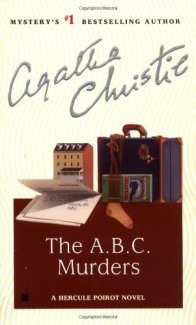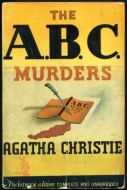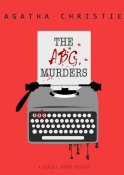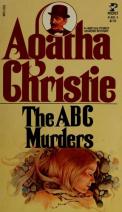After a deep study of The A.B.C. Murders, I see just how bad-ass Agatha Christie was. She truly earned the title “The Queen of Crime.” One way she earned her crown: her use of clues.
Part of any mystery’s fun is the deduction of a clue’s status: red herring, or genuine? Mysteries must be addled with both in order to satisfy both the narrative and the reader. That woman managed to make a ton of clues both red herrings and genuine clues, and it’s never clearer than in The A.B.C. Murders. It’s so clear, in fact, that some publisher thought it was smart to throw the most important elements of the mystery onto a book cover.

Gah, this one really pisses me off!
No, I’m not over-reacting.
Look, I get that all book covers need to attract readers, and what better way to draw readers to a mystery than by putting a mystery on the cover, right? If you pop on back to my earlier post on this story, you’ll see two covers that focus on different elements:
 You got your railway guide. Important, but not a giveaway.
You got your railway guide. Important, but not a giveaway.
 You got the killer’s shadow and A.B.C. Neither are giveaways.
You got the killer’s shadow and A.B.C. Neither are giveaways.
 Typewriter: Ibid.
Typewriter: Ibid.
 Corpse: Ditto Ibid. Etc. Etc. Etc.
Corpse: Ditto Ibid. Etc. Etc. Etc.
That one cover with the stockings and letter, though…THAT one is showing off a little too much. (Shout-out to Sarah Higbee for getting me into these book cover comparisons!)
Let’s start with the letters. The first arrives on page 4:
MR. HERCULE POIROT–You fancy yourself, don’t you, at solving mysteries that are too difficult for our poor thick-headed British police? Let us see, Mr. Clever Poirot, just how clever you can be. Perhaps you’ll find this nut too hard to crack. Look out for Andover on the 21st of the month. Yours, etc., A.B.C.
The other three letters have this same tone: confident and mocking, with oodles of superiority. Inspector Crome of Scotland Yard, Hastings, and others dismissed the initial letter, but after the first murder each letter is treated as a window into the mind of the killer. Three of the four letters arrive some days in advance, even, as a way to let Poirot and the Yard prevent the next crime, but Poirot and the Yard’s measures are never enough. Only one letter arrives late because of an incorrect address, which the Yard puts off as an accident:
Poirot gave [the letter] to [Inspector Crome].
He examined it, swearing softly under his breath.
“Of all the damned luck. The stars in their courses fight for the fellow.”
“You don’t think,” [Hastings] suggested, “that it was done on purpose?”
Crome shook his head.
“No. He’s got his rules–crazy rules–and abides by them. Fair warning. He makes a point of that. That’s where his boastfulness comes in. I wonder now–I’d almost bet the chap drinks White Horse whisky.”
“Ah, c’est ingenieux ca!” said Poirot, driven to admiration in spite of himself. “He prints the letter and the bottle is in front of him.”
The letters offer no forensic help, and only when the families of the first three victims come together does there seem to be any hope in catching the killer. In Chapter 21, Poirot deeply believes that conversation among the family members and witnesses will reveal the killer:
“Each one of us knows something about him–if we only knew what it is we know. I am convinced that the knowledge is there if we could only get at it.”
And sure enough, by the end of that chapter, a major connection is made when the third victim’s secretary recalls a stockings salesman coming to their door. The sister of the second victim mentions that her mother bought stockings for the victims the day she died. A reader can flip back and confirm what police say: a new pair of stockings was included in the first victim’s belongings.
Poirot presses the police to use the stockings angle, but they dismiss it as a coincidence. Of course they do! It’s only A MAJOR CLUE, right? And it does help: after the fourth victim is discovered, a man is spotted, bloody and bewildered, fleeing his room. A suitcase of new stockings was left behind. The man: Alexander Bonaparte Cust. A quiet man. Awkward. Shabby. Shy. Epileptic, and not medicated, so his memory has big gaps. He’s been to every location the day of a murder. He has a bloody knife, for crying out loud. The pressure to find him reaches such a fever that Cust himself walks into a police station in a daze and collapses.
So endeth the A.B.C. murders, yes? A typewriter in his room was the same used to write the letters. More stockings. More railway guides. All the clues are there….
And yet.
At the end of Chapter 31, Hastings wakes up from a nap to discover Poirot’s figured it out, and he’s going to be damned gleefully secretive about it. He’ll only say what he’s said before:
“There is nothing so dangerous for any one who has something to hide as conversation.”
Poirot meets face to face with Cust. Cust doesn’t recognize the detective’s name at all. He has no memory of the murders. Another man even remembers playing dominoes with Cust in a different part of the town where the second murder happened. And the second murder victim, a pretty young girl who liked to party, would NOT have given a guy like Cust the time of day, let alone her belt to be strangled with.
Yet the clues point to Cust. Cust even thinks he did the murders–he can’t remember those days, and as a stranger told him while reading his palm, he’s destined for the gallows…
Cust’s conversation reveals how some old clues are impacted by new clues. His character, for one, is in total contradiction with the letters. Unless the guy’s got split personality disorder, there’s no way a wuss like him is the snot who wrote the letters. He also talks about his dead-end job after the war, and the blessing that came with this selling job: a door-to-door job with a salary and commission. To any one with an iota of common sense, the idea of selling stockings door to door for a big salary and commission should sound questionable.
See what Christie did here? Those major clues–the letters, the stockings–were red herrings to take Poirot and the Yard to Cust. But those clues also reveal genuine hints of the true killer. By building us to this false climax of the killer caught, Christie increases tension a hundred fold. Despite Hastings’ skepticism (you’d think he’d know better by now), readers can’t help but read on to find out what Poirot’s discovered. I mean, I was super-peeved because my school contacted me about teaching and my son had the audacity to get sick. The wait until evening for those last fifteen pages was agony!
Chapter 34 is entitled “Poirot Explains,” for this is when all is explained to the families of the victims. Yes, it’s the typical gathering of suspects–it wouldn’t be a Poirot mystery without it. 🙂 Poirot focuses on the letters first: why write to Poirot, and not the Yard? Why commit these murders at all? Everyone else had thrown their hands up at “madness!” because that was the catchword of the day, apparently, and therefore everything’s justified. But Poirot points out that if a madman just wants to kill, why in Hades would he draw attention to himself, and therefore risk getting caught? He goes on with these contradictions found with the other clues, like the railway guide. There’s no discernable motive to be tied to Cust, or justification from any off-balance point of view.
So Poirot turns it all on its head with this base deduction about the letters:
“What was wrong with them was the fact they were written by a sane man!”
After all the “What?!?” by the victims’ families, Poirot points out how easy it is to hide something:
“When do you notice a pin least? When it is in a pin-cushion! When do you notice an individual murder least? When it is one of a series of murders.”
Now the letters become a major, genuine clue: the third letter, the only one mislabeled–the one Hastings wondered had been mislabeled on purpose–was for the murder that needed to happen without interference. When approached with that in mind, suddenly the true killer comes to the forefront: the boyish, adventurous, and broke brother of the third victim. He is one who could get that pretty girl to give him her belt. He is one with the snot-attitude that fits the letters to a T. He is one with the risk-taking spirit to kill in the open one night and approach the police the next. He had met Cust, and put the idea of the gallows destiny in his head. He planned out everything, from the bulk purchase of stockings and railway guides, to sending Cust the typewriter he used to type all the A.B.C. letters beforehand. He selected Poirot to get the letters because a letter addressed to Scotland Yard won’t go astray, but a letter to a private address can!
So yes, I’m still miffed about that one book cover. It took two of the most important pieces of the mystery and stuck them on the cover, forcing them to always be at the forefront of the reader’s mind. I’m also miffed this book isn’t used in more writing classes. It’s a brilliant piece of a mind-game: the clues alter in importance depending on the latest piece of information. What was once deemed important becomes a red herring only to become important again. And the fact that Christie gives us little chapters from Cust’s point of view early on makes us think we’re keeping tabs on the killer, and yet we can tell from those snippets what a shy, shabby fellow he is, devoid of confidence or wit. She’s giving us both a red herring and a real clue with every scene.
All method. No madness.
All hail the Queen of Crime!

You’re right – it’s a lovely example of excellent plotting by a writer at the top of her game. And yes – that cover! Grrr… Thank you for the shout-out:)) I’m really glad you enjoy them.
LikeLiked by 1 person
I do! You’re reminding me of authors I’ve been meaning to read as well as series I’ve never known about before. 🙂
And I’m glad you agree with me about that cover–it’s so infuriating. Plus, there’s no real mystery to it! A pox on that cover, I say!
LikeLiked by 1 person
Absolutely! It’s an inexcusable blooper for a publisher to make.
LikeLiked by 1 person
Well ‘Zat ‘as got my leetell grey cells’ working Ms Lee. Good thing my books are not of the murder/mystery genre…methinks you would have worked out the entire tale on just the one glimpse of the cover! Thinking about it the murder/mystery genre is about the only genre of book that great care needs to be taken vis-à-vis the cover art.
LikeLiked by 1 person
How right you are! I’ve been thinking about cover design a lot in regards to my own stories, and while one wants to engage readers with that initial image, one doesn’t just want to give away the story. That blasted letter/stockings cover does just that. Plus it’s really bland. I mean, that color scheme better fits a cook book than a mystery. Gah, I’ll be grumbling about it all over again now….
I’m terrible with working out mysteries, though. 🙂 I’m sure your plot would withstand my first read…and probably my third. 🙂
LikeLiked by 1 person
It’s truly a difficult thing is a cover. Luckily the wonderful Rachel in America did mine so I never had to think about it. Talking of books that reminds me…what an appalling memory I have. I need an address, any address you care to nominate for such things must cross the pond!
LikeLiked by 1 person
I’ll email ya’ 🙂
LikeLiked by 1 person
I can never think of what to say. I need a new album cover though and reading your post I think the photo of my guitar on my story on today’s post gives away my story.
LikeLiked by 1 person
I’m glad I got you thinking! I never realized how tricky cover art could be until I started reading S.J. Higbee’s blog. She does these weekly book cover comparisons; studying her posts has helped me realize just how tricky cover art is, as well as how it can give a very wrong impression about the story. The Harry Potter series is also a great example of how covers were redone to look more “adult,” and therefore, well, mislead readers as to the child-geared content.
LikeLiked by 1 person
It’s funny isn’t it? How little things that should be easy never are easy. The Beatles White Album has to be the best idea.
LikeLiked by 1 person
Have you ever seen the mockumentary “This is Spinal Tap”? They had their own such album: The Black Album. Oddly, sales weren’t very good because no one could see what the album was called… 😛
LikeLiked by 1 person
I’ve heard of it but never seen it. Perhaps they should have written the title white on black. I did rewatch Napoleon Dynamite the other day. Classic.
LikeLiked by 1 person
I don’t think Spinal Tap were well known for their common sense. 😛 As for Napoleon, I’ve never watched that in its entirety. The bits I saw were amusing, though!
LikeLiked by 1 person
Great post. My copy of this book is an ancient one with the corpse on the cover. Bought it in 1976 in Egypt. You’ve inspired me to read it again.
LikeLiked by 1 person
Oh lovely, thank you! And yes, do re-read. Even though I recalled some of the major plot points, it was a highly enjoyable read. 🙂
LikeLiked by 1 person
All Hail the Queen of Crime- love it, and love her stories! It’s interesting to take the time to analyze just WHAT makes them tick, and the deliberate skill that goes into directing the reader down the road you want them to follow. Thanks! I may have to make the hubby watch the movie version of this one now, which, yes, I have – he liked The Mystery of the Spanish Chest the other day 🙂 (And agreed on the cover. A bunch of the ones we have from that era are kind of similar- bland, but cluttered. Not fabulous.) xo
LikeLiked by 1 person
Oh fun! I do you two watch it–I got the film version from the library today! 🙂
LikeLike
How did it compare? (We haven’t managed it yet 🙂
LikeLiked by 1 person
I haven’t watched the film version just yet–I remember it being really good, though. It’s on my to-watch list in the next few days. 🙂
LikeLike
Super post by a lady who knows her books xxxxxxxxxxxxxxxxxxxxxxxxxx
LikeLiked by 1 person
Thank you, O Lovely Lady Shey. 🙂 xxxxxx
LikeLiked by 1 person
You are welcome oh lovely Lady Lee x
LikeLiked by 1 person
I enjoy reading your posts about Lady Agatha’s books 🙂 They are equally captivating. xx
LikeLiked by 1 person
Shucks, my dear. Thank you! 🙂 xxxxxx
LikeLiked by 1 person
I’m a sinner, my sweet java drinking buddy, because I STILL haven’t read any Agatha Christie!
I hope that doesn’t make you unfriend me on Facebook! 😧
As one who is keenly interested in book cover design, I got a kick out of seeing the different ones in this post. I can’t believe they published the one that “pisses you off” – what were these people thinking??? I think someone had too much wine, whiskey, brandy, or all three beverages mixed together when they were plotting out the cover design!
Anyway, I’ve been procrastinating on doing all kinds of things – this is day #3 of gloomy, rainy weather (it’s probably the perfect setting for an Agatha Christie murder, although I’m taking a wild guess!) and I’ve been escaping from reality by watching modern-day British murder shows on Netflix. (I’m taking a break from “Midsomer Murders” but I will return to it, without a shred of doubt!)
These shows, which I watch with Lucy while the kids watch “Star Trek” with their father, include “Paranoid,” “Marcella” and now “DCI Banks.” What’s rather odd is that I’ve never been into murder mystery dramas before. I don’t know why I’m so caught up with them now! Perhaps my next step of the Netflix binge journey is to plant myself in front of “Murder on The Orient Express” or “Miss Marple Mysteries.” What do you think? 🔪
LikeLiked by 1 person
Unfriend you? Never ever ever ever, my caffeinaterrific friend! And yeah, that cover…honestly, I wonder if whomever was stuck on those particular editions was used to doing something else, like cook books or…yeah, cookbooks! It’s the color scheme that gets me. “My, what a charming cookie collection. What’s with the stockings? HEY THIS ISN’T A COOKBOOK!”
Gloomy days are always excellent for murderous television…or space television, sure, why not? 😛 I don’t know of those three series, though…hmm…I think I’ve heard of the Banks one, dunno. Wouldja believe I’ve started watching the Poirot episodes now? I forget just how fun they are, like a cookie recipe one hasn’t done in an age, and now those cookies are the only thing you want to eat. David Suchet is just brilliant as Poirot.
Bo still doesn’t understand how I could real all this Poirot and not one Miss Marple. I don’t know if they’re worth the watch–maybe you’ll beat me to’em!
Ugh, back to school stuff. Have fun with murderous gloom and doom this wintry eve….bwa ha ha ha (thunderous lightningous stormerousousousness) 😛
LikeLiked by 1 person
G’morning, lovely! I’m not surprised you started watching the “Poirot” episodes at all, & I’m happy that Suchet gives an outstanding performance! The name “Miss Marple” has always gotten to me…in a good way. There’s something endearing about it, so maybe I will check it out before, gasp…you! 😛
I’m proud of you for working so diligently on the school tasks – they don’t know how lucky they are to have you as their mega-talented teacher – “they” being both students and admin! 💖
LikeLiked by 1 person
Oh, do! I’d love your feedback on her!
LikeLiked by 1 person
What’s interesting about book covers is International book covers! I never knew about different covers until I traveled overseas…and the evolution of book covers is also interesting, from illustrations, to stock photos, and as the ABC book cover attests – ‘dumbing it down’ for the reader.
All Hail the Queen, indeed. Love Agatha.
LikeLiked by 1 person
Thanks so much for reading! You know, I never thought about covers either until the Harry Potter series came out, and there was a news stories about the “grown-up” covers made so adults wouldn’t be embarrassed reading the books in public. Sara Higbee does these kinds of comparisons every week; they’re so neat, even for stories I don’t know.
LikeLiked by 1 person
Clueobsessed.
LikeLiked by 1 person
Amen to that. 🙂 I owe your site a visit in the near future, too…. 😛
LikeLike
Pingback: Sunday Post – 11th December 2016 | Brainfluff
Pingback: Lessons Learned from Agatha Christie: Clunk and move on. – Jean Lee's World
Pingback: Lessons Learned from Agatha Christie: Even a B Novel Should Have an A Title. | Jean Lee's World
Pingback: Lessons Learned from Agatha Christie: The Omission Says It All. | Jean Lee's World
Really enjoy reading your posts regarding
Agatha Christie novels. You certainly know your stuff.
I’ve just started reading The Clocks.
LikeLiked by 1 person
Thank you so very much! I devoured the Poirot novels when I was a kid. It can be a challenge taking off the ol’ nostalgia-glasses, but I figure there have to be reasons Christie stories endure for so darn long. 🙂
LikeLiked by 1 person
When I was a kid I couldn’t read all the Sherlock Holmes
stories quick enough. Both Conan Doyle and Christie certainly
have endured the passage of time. 😀
LikeLiked by 1 person
They have indeed. And I loved the Holmes stories, too! Wonder if I should study them sometime…
LikeLiked by 1 person
That sounds like a fantastic idea.
I would love to read your thoughts on the Holmes stories.
LikeLiked by 1 person
🙂 I admit, I don’t think I could do a ton, but a few stories and a novel might be neat!
LikeLiked by 1 person
Christie was an amazing author and at the top of her game until she passed. Thanks for sharing and enjoy the day.
LikeLiked by 1 person
Thank you for reading and enjoy the day!
LikeLiked by 1 person
Never really thought about the cover. My version on checking is a blue cover with a typewriter. Top effort from Agatha on this story.
LikeLiked by 1 person
Oh yes, that’s why it’s one of my favorites 🙂
LikeLiked by 1 person